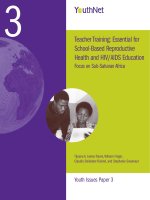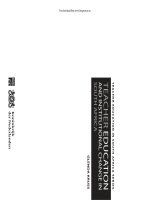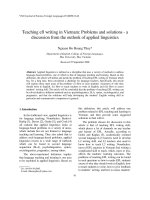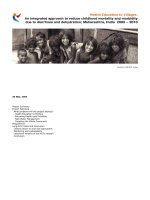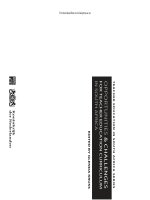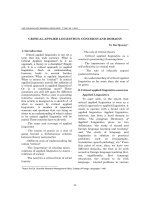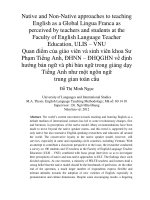Springer applied linguistics and language teacher education (2005) 1402079052
Bạn đang xem bản rút gọn của tài liệu. Xem và tải ngay bản đầy đủ của tài liệu tại đây (8.69 MB, 442 trang )
Applied Linguistics and
Language Teacher Education
Educational Linguistics
Volume 4
General Editor:
Leo van Lier
Monterey Institute of International Studies, U.S.A.
Editorial Board:
Marilda C. Cavalcanti
Universidade Estadual de Campinas, Brazil
Hilary Janks
University of the Witwatersrand, South Africa
Claire Kramsch
University of California, Berkeley, U.S.A.
Alastair Pennycook
University of Technology, Sydney, Australia
The Educational Linguistics book series focuses on work that is:
innovative, trans-disciplinary, contextualized and critical.
In our compartmentalized world of diverse academic fields and
disciplines there is a constant tendency to specialize more and
more. In academic institutions, at conferences, in journals, and in
publications the crossing of disciplinary boundaries is often discouraged.
This series is based on the idea that there is a need for studies that
break barriers. It is dedicated to innovative studies of language use
and language learning in educational settings worldwide. It
provides a forum for work that crosses traditional boundaries
between theory and practice, between micro and macro, and
between native, second and foreign language education. The series
also promotes critical work that aims to challenge current practices
and offers practical, substantive improvements.
The titles published in this series are listed at the end of this volume.
Nat Bartels
Editor
Applied Linguistics and
Language Teacher Education
Springer
eBook ISBN:
Print ISBN:
1-4020-2954-3
1-4020-7905-2
©2005 Springer Science + Business Media, Inc.
Print ©2005 Springer Science + Business Media, Inc.
Boston
All rights reserved
No part of this eBook may be reproduced or transmitted in any form or by any means, electronic,
mechanical, recording, or otherwise, without written consent from the Publisher
Created in the United States of America
Visit Springer's eBookstore at:
and the Springer Global Website Online at:
Contents
Foreword
ix
Part I: Teacher Education and Applied Linguistics
1
Researching Applied Linguistics in Language Teacher Education
Nat Bartels
2
Using Bulgarian Mini-Lessons in an SLA Course to Improve the KAL of
American ESL Teachers
Maria Angelova
3
The Impact on Teachers of Language Variation as a Course Component
Corony Edwards & Charles Owen
4
Integrating Language Teachers’ Discipline Knowledge in a Language
Course
Josep M. Cots & Elisabet Arnó
1
27
43
59
Part II: Applied Linguistics and Changes in Teachers’ Conceptions,
Attitudes and Intentions
5
Constructing Theoretical Notions of L2 Writing Through Metaphor
Conceptualization
Olga S. Villamil & Maria C. M. de Guerrero
6
What’s the Use of Linguistics? Pre-Service English Teachers’ Beliefs
towards Language Use and Variation
Salvatore Attardo & Steven Brown
7
The Effects of Training in Linguistics on Teaching: K-12 Teachers in
White Mountain Apache Schools
Florencia Riegelhaupt & Roberto Luis Carrasco
79
91
103
8
What Teachers Say When They Write or Talk about Discourse Analysis
Anna Elizabeth Balocco, Gisele de Carvalho & Tania M. G. Shepherd
9
Relevance of Knowledge of Second Language Acquisition: An in-depth
case study of a non-native EFL teacher
Yi-Hsuan Gloria Lo
119
135
Part III: Investigating Teachers’ Knowledge and Knowledge Use
through Teacher-Like Tasks
10
Knowledge about Language and the ‘Good Language Teacher’
Stephen Andrews & Arthur McNeill
11
Pre-Service ESL Teachers’ Knowledge about Language and its Transfer
to Lesson Planning
Martha H. Bigelow & Susan E. Ranney
159
179
12
What’s Phonetics Got to Do with Language Teaching? Investigating
Future Teachers’ Use of Knowledge about Phonetics and Phonology
Amy E. Gregory
201
13
Raising Orthographic Awareness of Teachers of Chinese
Yun Xiao
221
Part IV: Investigating Teachers’ Use of Knowledge about Language
When Teaching
14
Realisation(s): Systemic-Functional Linguistics and the Language
Classroom
Anne Burns & John Knox
235
15
Researching the Effectiveness of Professional Development in Pragmatics
Lynda Yates & Gillian Wigglesworth
261
16
Why Teachers Don’t Use Their Pragmatic Awareness
Maria Cristina Lana Chavez de Castro
17
Teacher Trainees’ Explicit Knowledge of Grammar and Primary
Curriculum Requirements in England
Jane Hislam & Wasyl Cajkler
18
Knowledge about Language and Testing
Clover Jones McKenzie
281
295
313
Part V: The Complexity of Teachers’ Knowledge about Language
19
Experience, Knowledge about Language and Classroom Practice in
Teaching Grammar
Simon Borg
20
Discourse Analysis and Foreign Language Teacher Education
Julie A. Belz
21
Storytelling into Understanding: Middle School Teachers Work with Text
Analysis and Second Language Reading Pedagogy
Amy Cecelia Hazelrigg
22
How MA-TESOL Students Use Knowledge about Language in Teaching
ESL Classes
A. Jeff Popko
325
341
365
387
23
Applied Linguistics and Language Teacher Education: What We Know
Nat Bartels
405
Index
425
This page intentionally left blank
FOREWORD
Applied linguistics has a lot to offer language teachers. The field has produced a wealth
of knowledge about language (KAL), from uses of a language’s sound system to create
meaning, to factors that affect language learning, to knowledge of how people structure
conversations, to ways of using language to signal membership in particular language
communities, among other issues. Courses on applied linguistics play a major and
integral role in teacher education programs around the world and applied linguists are
prominent in any discussion of language teacher education. However, any program
conception, course, lesson plan, or interaction with learners of teaching can be seen as a
theory of practice (van Lier, 1996); a theory of what language teachers need to know and
what kind of learning experiences will help them develop this knowledge. Furthermore,
while there has been much theoretical work on what teachers need to know about
language and the role this knowledge might play in language teaching and learning to
teach (e.g. Stern, 1983; Widdowson, 1990; Bardovi-Harlig & Hartford, 1997; Fillmore
& Snow, 2002), there has been little systematic research on the effect of applied
linguistics instruction on language teachers’ knowledge and practice (Bartels, 2002;
Borg, 2003). Not only might the relationship between applied linguistics knowledge and
language teaching be more complex than theorized, it is also possible that we are,
unwittingly and with the best of intentions, imposing practices of the applied linguistics
discourse community on language teachers during teacher education which are not
helpful for the practice of language teaching (Bartels, 2003; Bolitho, 1987; Clarke,
1994), something I refer to as linguistics imperialism (Bartels, in press).
Therefore, if we want to (a) avoid a situation where applied linguists are colonizing
(Gee, 1990) novice teachers, however well meaning, by requiring them to apprentice
themselves to the field of applied linguistics rather than to language teaching, and (b)
defend our status as an applied science and make contributions to research questions
shared by other disciplines, it is important for applied linguists working in language
teacher education to investigate their theories of practice in a rigorous and thorough
manner. This book is meant as a beginning to such an endeavor. It presents 21 studies by
applied linguists investigating their own theories about language teachers’ knowledge
and language teachers’ learning and use of KAL in pre-service or in-service programs.
The purpose of this book is to provide teachers of applied linguistics with (a) state of the
art knowledge about and insights on applied linguistics and language teacher education,
(b) the tools needed to research their own theories of practice, and (c) an insider
perspective of how a wide variety of teachers of applied linguistics perceive and
investigate their own theories of practice. In order to accomplish the last goal, every
effort has been made to preserve project the individual voices of the researchers within
the book. The authors have been asked not only to situate their studies within the needs
of the research community, but also to make clear their own personal reasons for
pursuing their research questions and to make clear what they learned from engaging in
their research projects. Furthermore, the authors have been encouraged to use a personal
x
FOREWORD
tone in their chapters and their personal preferences in terms of the type of English they
use, subject headings, length of bibliography, etc. have been preserved.
Furthermore, while this volume focuses on the relationship between applied
linguistics and learning to teach languages, this is a much broader issue. In most
university settings applied linguists actively teach knowledge about language to prepare
people for a variety of vocations and tasks. While language teaching may be the most
significant vocation in terms of numbers, KAL is also used in preparing people to be
translators, interpreters, lexicographers, journalists, editors, formulators of policy on
language planning, as well as to help people learn to diagnose and treat language
disorders, examine linguistic issues in legal cases, etc. Therefore, I would propose that
we also need a subfield of applied linguistics, Metalinguistics, devoted to investigating
and theorizing about the acquisition and use of knowledge about language when learning
any kind of vocation or task. Thus, the contents of this book should not only be
important for those interested in a deeper understanding of the role of applied linguistics
in teacher education and ways of investigating this role; the research methods and results
in this book can also be used as a foundation for those interested in other metalinguistic
topics.
The book is organized into 5 parts, the first of which is the most heterogeneous.
Chapter 1 (Bartels) presents a wide variety of research tools that can be used for studies
of learning and use of applied linguistics knowledge. The next chapters look at the
impact of a particular KAL teaching activity, mini-language lessons, on novice teachers’
knowledge and conceptions about language learning (Angelova: chapter 2), the use of an
internet-based questionnaire to investigate students’ post-hoc attitudes towards a
sociolinguistics course (Owens & Edwards: chapter 3), and the extent to which the roles
of language analyst, user and teacher are integrated in a language-focused course
addressed to future non-native EFL teachers (Cots & Arno: chapter 4).
Section 2 focuses on changes in teachers’ conceptions, attitudes and intentions due to
educational experiences focusing on writing (Villamil & Guerrero: chapter 5), language
variation (Attardo & Brown: chapter 6; Riegelhaupt & Carrasco: chapter 7), discourse
analysis (Balocco, Carvalho & Shepherd: chapter 8), and second language acquisition
(Lo: chapter 9).
The studies in section 3 and 4 investigate how teachers use their KAL in teaching.
The studies in section 3 use a variety of laboratory-type tasks (analyzing and providing
feedback on learner language, lesson planning) to look at what expert and/or novice
teachers know and can do with their KAL on syntax and vocabulary (Andrews &
McNeill: chapter 10), content-based teaching and grammar (Bigelow & Ranney: chapter
11), phonetics and phonology (Gregory: chapter 12), and orthography (Xiao: chapter
13). In section 4, however, the studies focus on teachers’ use of KAL during actual
classroom teaching, focusing on systemic-functional linguistics (Burns & Knox: chapter
14), pragmatics (Yates & Wigglesworth: chapter 15; Chaves de Castro: chapter 16),
syntax (Hislam & Cajkler: chapter 17), and L2 writing (McKenzie: chapter 18).
FOREWORD
xi
Section 5 presents studies which investigate the complexity of teachers’ knowledge
about applied linguistics and the complexity of the process of using this knowledge for
language teaching. This section includes studies focusing on knowledge of grammar
(Borg: chapter 19), discourse analysis (Belz: chapter 20), systemic-functional linguistics
and L2 writing (Hazelrigg: chapter 21), as well as an entire MA program (Popko:
chapter 22). The final chapter in the book (Bartels: chapter 23) summarizes the findings
from these studies, analyzes them using research and perspectives from fields such as
education and cognitive psychology, and poses questions for future investigation in this
field.
Finally, I would like to acknowledge my appreciation to those who made this book
possible. I would like to thank the contributors to this volume who not only invested
significant amounts of time to design, carry out, and write up research projects related to
the theme of the book, as well as giving feedback on each others’ chapters, but who were
also very patient with all the mistakes that their novice editor made during the whole,
long process, despite the strenuous circumstances in their own lives. I would also like to
thank Leo van Lier for his impromptu suggestion to take the idea of a proposed
conference symposium and make it into a book. I am very grateful to Julie Kerekes,
Jennifer Ewald, and Lara Hermans for reading some of the chapters and providing
insightful feedback to the authors. In addition, the comments of the two anonymous
outside readers were very helpful in helping the other contributors and myself to tighten
the focus of the book. Charlynn Christensen deserves special thanks for doing much of
the formatting of the book manuscript. I am grateful also to Trevor Warburton for his
work on the index and final formatting of the book. Finally, I would like to thank
Henrike, Franziska and Marika Bartels for tolerating my many absences caused by work
on this book and for taking over many of my family chores so I could complete this
book. I could have not have done it without you.
Nat Bartels
Friday, February 13, 2004
Logan, Utah, USA
xii
FOREWORD
REFERENCES
Bardovi-Harlig, K. & Hartford, B. (1997). Beyond Methods: Components of Second Language Teacher
Education. New York: McGraw-Hill.
Bartels, N. (2002).. Action research and professional preparation: Only for language teachers? TESOL
Quarterly. 36(1), 71-79.
Bartels, N. (2003). How teachers and academics read research articles. Teaching and Teacher Education,
19(7), 737-753.
Bartels, N. (in press). Comments on Robert Yates and Dennis Muchisky’s “On Reconceptualizing Teacher
Education”. A reader reacts. TESOL Quarterly, 37(1).
Bolitho, R. (1987). Teaching, teacher training and applied linguistics. In V. Bickley (Ed.), Re-Exploring CELT.
Hong Kong: Institute for Language in Education.
Borg, S. (2003). Teacher cognition in language teaching: A review of research on what language teachers
think, know, believe, and do. Language Teaching, 36(2), 81-109.
Clarke, M. (1994). The dysfunctions of the theory/practice discourse. TESOL Quarterly, 28(1), 9-26.
Fillmore, L. & Snow, C. (2002). What teachers need to know about language. In C. Adger, C. Snow, & D.
Christian, (Eds.), What Teachers Need to Know about Language. Washington, DC, and McHenry, IL:
Center for Applied Linguistics and Delta Systems Co., Inc.
Gee, J. (1990). Social Linguistics and Literacies: Ideology in Discourses. Philadelphia: Falmer.
Stern, H. (1983). Fundamental Concepts of Language Teaching. Oxford: Oxford University Press
van Lier, L. (1996). Interaction in the Language Curriculum: Awareness, Autonomy, and Authenticity. Boston:
Addison-Wesley
Widdowson, H. (1990). Aspects of Language Teaching: Oxford: Oxford University Press.
Chapter 1
Researching Applied Linguistics in Language
Teacher Education
Nat Bartels
Utah State University‚ USA
INTRODUCTION
That language teachers need to know about applied linguistic fields such as pedagogical
grammar‚ discourse analysis‚ second language learning‚ etc. would seem to be selfevident (Flynn‚ 1994; Tyler & Lardiere‚ 1996). However‚ the knowledge that teachers
use in their practice‚ however‚ is more complicated that just knowing facts‚ using facts‚
and general conceptions of language and language learning. In order to produce quality
research on language teachers’ learning in applied linguistics courses and their use of
their KAL in teaching‚ we need to move away from folk psychology conceptions of the
mind (Strauss‚ 2001) to a more sophisticated and complex view of knowledge‚
knowledge acquisition‚ and knowledge use. If a broader conception of what kinds of
knowledge language teachers need and use it to be investigated‚ a great variety of
research methodology will be necessary. Therefore‚ the purpose of this chapter is to
introduce to a wide range of data collection tools and indicate resources which can be
used for those interested in investigating the theories behind their practices as teachers of
applied linguistics. Lists of a number of studies using each research tool will be provided
for readers who wish to familiarize themselves with ways that certain research methods
have been used to investigate specific questions in order to deepen their knowledge of
these research tools and‚ perhaps‚ to inspire their own research.
However‚ it will not be possible in the space available here for a complete
presentation of various research perspectives or a full discussion of the task of
researching teacher knowledge or each data collection tool. This has been done
elsewhere and need not be repeated here. For summaries of research methodology in (a)
applied linguistics see Freeman (1996; 1998)‚ Hornberger & Corson (1999)‚ Nunan
(1992)‚ and McDonough & McDonough (1998); (b) educational research see Bogdan &
Biklen (1998)‚ Byra & Karp (2000)‚ Maxwell (1996)‚ and Miles & Huberman (1994)‚
N. Bartels (ed.) Researching Applied Linguistics in Language Teacher Education‚ 1-26.
2
RESEARCHING APPLIED LINGUISTICS
and Royer‚ Cisero & Carlo (1993); and (c) cognitive psychology see Cooke (1999)‚ Patel
& Arocha (1995) and Olsen & Biolsi (1991).
DATA COLLECTION METHODS
There are four main categories of data collection presented in this section: observation‚
documentation‚ reports and introspection‚ and tasks. Researchers seriously considering
triangulating their research‚ i.e. using multiple sources of data to increase research
credibility (Davis‚ 1995; Denzin & Lincoln‚ 1994)‚ might want to consider choosing data
collection instruments from a variety of these four categories. Foss and Kleinsasser
(2001) have shown that different types of data ‚ such as questionnaire data or observation
data‚ reveal different aspects of teachers’ knowledge and so the use of a variety of
instruments is necessary to get a fuller picture of teachers’ knowledge. (See Johnson‚
1992‚ 1994‚ 1996‚ Westerman‚ 1991‚ or Woods‚ 1996‚ for excellent examples of
triangulation in studies of teacher learning and teacher knowledge.) Triangulation is seen
as increasingly important in the study of teacher cognition‚ as many studies have found
that reliance on single or similar sets of data can result in misleading research results
(e.g. Foss & Kleinsasser‚ 2001; Zeichner & Tabachnick‚ 1981).
OBSERVATION
One of the most common ways of collecting data about teachers’ knowledge and
knowledge use is by observing them teaching (Borg‚ 1998; 1999; Lamb‚ 1995:
Grossman‚ 1990; 1991; Calderhead & Shorrock‚ 1997‚ Carpenter et al‚ 1989). While this
usually entails observation of school teaching only‚ it may also include observing all
aspects of a particular practice such as informal conversation with colleagues on goals
for a course‚ discussions with parents or administrators‚ etc. (Dunbar‚ 1995). An
alternative to direct observation is to tape classes and then analyze the transcripts
(Johnston & Goettsch‚ 1999; Villamil & Guerero‚ 1998). Observation is good for
looking at whether teachers really use the knowledge from applied linguistics courses in
their teaching practice‚ and also produces data for examining their routines and
schemata. However‚ observation can be very time consuming so most researchers limit
the number of visits they make and the number of teachers the observe‚ which then
raises questions about the generalizability of the findings. One potential problem with
observing classes of your students or former students is that they may feel compelled to
do things they think you want to see‚ rather than teach the way they would if you were
not there (Duffy & Roehler‚ 1986). Therefore‚ it is important to gain the teachers’ trust
so that they feel free to teach in any way they wish. You also may be able to get around
this by having them observed by a co-researcher who has not been their teacher. For
suggestions of how to record data while observing see Freeman (1998)‚ Boglan &
Bicklen (1992)‚ and Day (1990).
BARTELS
3
If you want to investigate the learning of teachers or novice teachers in a particular
applied linguistics class or in-service training meeting‚ these situations can be observed
as well. If you teach the class‚ you can either have a co-researcher observe your class or
record the class and later analyze the transcripts (Southerland & Gess-Newsome‚ 1999;
see also Samway‚ 1994‚ for further suggestions). Using observation data from applied
linguistics classrooms can give you more detailed information about what students are
really learning in your applied linguistics classes and can also be compared with
observation of teaching data to investigate the extent of transfer from the applied
linguistics class to language teaching. It is also fairly convenient because‚ if you are the
instructor‚ you have to attend the class anyway.
Some researchers use participant observation‚ meaning they use the knowledge they
gained as a participant (usually the instructor) in the course (Bailey‚ 1996‚ Ramanthan et
al‚ 2001; Belz‚ chapter 20; Bigelow & Ranney‚ chapter 11). Being a participant observer
4
RESEARCHING APPLIED LINGUISTICS
can give you a richer‚ insider perspective on the learning taking place in an applied
linguistics class‚ although the researcher may be so preoccupied in her view that
important perspectives on the class are ignored. This can be alleviated by including data
from other participants in the class‚ taping classes and analyzing transcripts‚ or by having
an outside observer to compliment your perspective as participant observer. (See Byra &
Karp‚ 2000‚ for descriptions of and guidelines for participant observation.)
DOCUMENTATION
A similar source of data are documents and artifacts from teaching‚ for example lesson
plans‚ teaching materials‚ and student work. Such data provides a picture of teachers’
knowledge in use‚ schemata and routines‚ especially when combined with data from
observation and/or report data. It can also provide more detailed data than observation
alone‚ for example if you want to look at teacher marking and comments on students’
written work. However‚ this method can produce quite a lot of data‚ so it is wise to plan
beforehand exactly what kind of documents you want to examine in order to reduce the
volume of data to by analyzed.
Of course‚ you can also collect documents and artifacts from applied linguistics classes‚
too. Student work is a convenient source of data because you collect it anyway and then
all you need to do‚ after getting the proper permission from the students and any research
review board at your institution‚ is to copy the student work before handing it back to the
students.
BARTELS
5
REPORTS AND INTROSPECTION
This category includes a number of data collection tools where teachers report or attempt
to verbalize what they do‚ why they do it‚ what they believe‚ what they are or were
thinking‚ and other reports of their cognitive activity. These methods can work very well
to investigate propositional knowledge‚ procedural knowledge‚ and knowledge
organization. This type of data is an ideal compliment to observation data because it
focuses on the participants’ “insider” perspective on what doing the task entails;
perspectives which observation data seldom reveal. However‚ it is important to keep in
mind that the participants verbalizations do not represent the actual thoughts of the
participants‚ but rather their estimation of their thoughts (Freeman‚ 1994). For an indepth discussion of introspective data collection methods see Ericsson & Simon (1993).
Interviews
Interviews are often useful for investigating teachers’ insider perspectives on what they
do and especially why they do the things they do. They also allow the researcher to focus
on specific questions and to elicit attitudes and espoused conceptions‚ routines‚ agendas
and scripts. Espoused knowledge‚ however‚ may vary from what is actually used when
teaching. While most interviews are with individuals‚ focus groups can also be
interviewed. (See Byra & Karp‚ 2000‚ for description and guidelines of both individual
and focus group interviews.) A relative disadvantage of interviews is that they take a lot
of time to conduct‚ transcribe and analyze‚ which usually limits the number of
participants who can be interviewed. Interviews can focus on a specific body of
knowledge (Alanen; 2003) or task (Strauss et al‚ 1999)‚ be used to frame teachers’
thoughts before and after teaching (Woods‚ 1996) or to investigate mental models (Gott
6
RESEARCHING APPLIED LINGUISTICS
et al‚ 1993; Strauss et al‚ 1998). Table 1 presents a list of studies using interviews to
research teacher knowledge and teacher learning. For more information on composing
interview questions‚ see Foddy (1994) or Seidman (1998). For a finely detailed look at
an interview tool see Kennedy‚ Ball and McDiarmid (1993).
Questionnaires
There are several different kinds of questionnaires such as Likert scale questionnaires
(where participants choose a response on a continuum)‚ checklist questionnaires (where
participants check of actions they do‚ values they share‚ information they are familiar
with‚ etc.)‚ and open-ended questionnaires (where participants write answers to specific
open-ended questions). Likert scale questionnaires are convenient data collection
instruments as they are easy to use with large numbers of participants and offer clear‚
numerical data which is easy to analyze. Questionnaires can focus on both specific
knowledge about teaching and pedagogical content knowledge (for an excellent example
see Kennedy‚ Ball & McDiarmid‚ 1993) or teachers’ conceptions of and attitudes
towards teaching and their content knowledge (Fang‚ 1996; Horwitz‚ 1985). When
questionnaires are used to investigate teachers beliefs or conceptions of language
learning‚ it should not be assumed that changes in these reported beliefs directly reflect
changes in how teachers conceive of and carry out their teaching (e.g. MacDonald‚
Badger‚ & White‚ 2001) as studies have shown that general beliefs and those used for
actual teaching are often divergent (Foss & Kleinsasser‚ 2001; Kennedy‚ 1996; Zeichner
&Tabachnick‚ 1981)
In general‚ questionnaires should not be used alone‚ but triangulated with data from
other sources in order to establish the credibility of the results (Fang‚ 1996; Kalaja &
Barcelos‚ 2003; Kennedy‚ Ball & McDiarmid‚ 1993; Parajes‚ 1992). If used alone‚ they
should have not only abstract‚ general questions‚ but should also include specific
BARTELS
7
questions on knowledge of classrooms and the teachers’ classroom behavior (Attardo &
Brown‚ chapter 5; Yaakobi & Sharan‚ 1985). Care needs to be taken when constructing
questionnaire items and it is always a good idea to trial items‚ check if they are really
testing what you want‚ and then revise items in the questionnaire (Brindley & Schneider‚
2002‚ Yaakobi & Sharan‚ 1985). For example‚ the questionnaire used by MacDonald‚
Badger and White (2001) and Kerekes (2001) was not designed as a questionnaire tool
and does not come from any data on teachers’ beliefs‚ but was based on general ideas
about language learning that Lightbown and Spada felt were important for teachers to
explore in the context of SLA research (Lightbown & Spada‚ 1999). The items in the
BALLI questionnaire developed by Horwitz (1985) were elicited from teachers.
However‚ Horwitz only elicited general‚ context-less‚ espoused conceptions of language
learning which are very different from the kinds of context-bound‚ in-action conceptions
which shape teachers’ plans and actions (Woods‚ 1996). One way of avoiding this
problem is to use a questionnaire to provide information about a specific policy or
document. For example‚ Allen (2002) investigated the extent to which teachers’
conceptions of language teaching were similar to the standards for foreign language
education. In this situation‚ revising the standards statements into questionnaire items is
relatively easy. For more information on constructing questionnaire items see Converse
& Presser (1986)‚ Dörnyei (2003)‚ or Fowler (1995). For more detail on the kind of
knowledge questionnaires tap into and the influence of item construction on this see
Tourangeau‚ Rips & Rasinki (2000) or Sudman‚ Bradburn & Schwarz (1996). The
internet is also making questionnaires easier to distribute and fill out as well as to
analyze the data. If you are interested in using a web-based questionnaire‚ Owen and
Edwards (chapter 3) present and evaluate an example of a web-based questionnaire‚
while Dillman (1999) discusses ways of conducting survey research online.
A variation of the normal Likert scale questionnaires is the Q-Sort procedure or QMethodology (McKeown & Thomas‚ 1988). The Q-Sort procedure begins with
statements much like a questionnaire. However‚ instead of rating each statement
independent of the other‚ participants are asked to rank the statements on a scale
8
RESEARCHING APPLIED LINGUISTICS
showing the extent of their agreement with the statements. This ranking‚ however‚ has to
take the form of a normal‚ bell-shaped distribution. For example‚ in the study by
Corthran and Ennis the participants:
systematically rank-ordered a series of cards... [containing] 40 statements that reflected
possible values for physical education. The participants were asked to sort the cards
along a 9 point continuum from the most to least valued. The number of cards allowed in
each of the 9 points along the continuum was 3, 4, 4, 6, 6‚ 4‚ 4‚ 3, respectively. For
example‚ the three most valued items were places on the farthest right hand column with
the next four most valued items in the next column (Corthan & Ennis‚ 1998: 313).
This procedure produces data that is easy to analyze statistically (because of the bellshaped distribution) and allows for easier comparison of the items against each other.
An alternative to Likert scale questions is to provide participants with lists of activities
they do (Dunn & Shriner‚ 1999) or reasons they have for certain actions (Li‚ 1998) and
have them select all relevant items. Questionnaires can also contain open-ended
questions in order to collect extended qualitative data. Pennington (1996)‚ for example‚
not only had the teachers she was studying rank different aspects of their teacher
education program‚ but also to comment on why they gave a certain ranking.
Journals
Data from journals or diaries kept for an applied linguistics class or during teaching is a
common way to collect quality data on teachers’ perspectives on their knowledge and
knowledge use. Participants can either be requested to focus on particular topics
(Angelova‚ chapter 2; Dunn & Shriner‚ 1999) or to simply reflect on their teaching and
BARTELS
9
learning (Numrich‚ 1996; Pennington‚ 1995). It can also be an excellent way of
collecting longitudinal data (Hosenfeld‚ 2003). For teachers of applied linguistics‚
collecting journal data can be much less time consuming than other data collection
methods‚ especially if learner journals are already integrated into the course or practicum
you are investigating and the journals are submitted in electronic form.
Metaphors
Metaphors have also been used to investigate teachers’ knowledge and cognition. This
includes metaphors which occur naturally in interview or other data (source) as well as
data from tasks that specifically ask participants to produce metaphors. The theory is that
the metaphors people create or chose to use reflect their conceptions of the phenomena
they are using the metaphors to represent. The analysis can include identifying themes or
attitudes contained in the metaphors.
Narrative and Biographic Methods
As mentioned earlier‚ much of teachers’ knowledge is bound up in stories of their
experiences both as students and as teachers. An effective way of accessing this kind of
knowledge is using narrative and biographic data collection methods. There are three
general directions this can take. First‚ data can be either general stories (“How do you
remember learning French?”) or on specific aspects of teaching (“What happens when
10
RESEARCHING APPLIED LINGUISTICS
you try to focus on fluency?”). Data collected from language learning/teaching
autobiographies will be more filtered than just asking for stories‚ but it can produce more
focused data because the participants explain how their experiences influenced their
teaching. It is also possible to collect autobiographies at different points in a teacher’s
development in order to assess how their view of teaching has changed over time or due
to the influence of a course in applied linguistics (Bailey et al‚ 1996; Polettini‚ 2000).
Another advantage of the autobiographies is that many teacher educators use them as a
teaching tool‚ so if you incorporate this into your teaching‚ data collection will be much
easier. For data looking specifically at how experiences might have shaped a teachers’
knowledge and conceptions of teaching‚ one can ask them to describe critical incidents
in their lives where they learned something about teaching‚ language learning‚ phrase
structure rules‚ or whatever you want to focus on (Flanagan‚ 1954; Kagan‚ 1993).
The caveat with such data is that such data represents teachers’ interpretations of
their experiences‚ not the actual knowledge itself. Wubbels‚ Brekelmans and
Hooymayers (1992) showed that teachers’ reports of instruction do not always match
their actual behavior in those classes. However‚ analysis of ways experienced and
inexperienced language teachers talk about teaching show that this does reveal
differences in their knowledge (Meskill‚ Mossop‚ DiAngelo & Pasquale‚ 2002). For an
introduction on using these methods see Clandinin & Connelly (2000)‚ Kelchtermans
(1994) or Solas (1993).
BARTELS
11
Think Alouds
In think aloud tasks participants are usually asked to think out loud or to vocalize every
thought that passes through their heads while they are engaged in a task in the domain
under scrutiny. As Ericsson and Simon (1993) point out‚ however‚ these are‚ in many
ways‚ two very different tasks. When participants do their thinking out loud‚ this focuses
on verbal thoughts and perceptions and non-verbal thoughts and knowledge such as
images and feelings will not be part of the data. However‚ if participants are asked to
verbalize every thought‚ putting non-verbal thoughts such as images or feelings into
words is a difficult task‚ so such data may be problematic. Think alouds can be easily
adapted to most kinds of solitary activities such as lesson planning (Byra & Sherman‚
1993)‚ responding to written work (Cohen & Cavalcanti‚ 1990)‚ or assessing information
in specific situations (Lesgold‚ 1984; Sabers‚ Cushing & Berliner‚ 1991). However‚ it is
difficult to apply this methodology to tasks which are interactive such as classroom
teaching or conferencing. (See also van Someren‚ Barnard & Sandberg‚ 1994). Within
applied linguistics‚ think aloud methodology has been mainly used in investigating
processes of language learning (Gass & Mackey‚ 2000).
Stimulated Recall
In stimulated recall tasks‚ participants perform a task (teach a lesson‚ mark a paper‚
consult with a student‚ etc.). Then they are presented with some kind of stimulus (usually
a video or audio tape of them completing the task although the researcher may share
notes taken during the activity) and asked to stop the tape (or interviewer) at any point in
the task they think is significant and to say what they were thinking at that point. The
researcher may also pose questions to elicit clues to the thinking behind certain actions
or decisions during the task. One disadvantage is that this methodology requires a lot of
organizational work. Besides coordinating recording and playback equipment for both
the stimulus and the stimulated recall data itself‚ the stimulated recall task should be
12
RESEARCHING APPLIED LINGUISTICS
done right after the teaching activity (Færch & Kasper‚ 1987)‚ which can make data
gathering in busy school contexts challenging.
Repertory Grid
The repertory grid originates from Kelly’s Personal Construct Psychology (Kelly‚ 1955).
(See Solas‚ 1992‚ for further discussion of the theoretical background to the repertory
grid.) The grid measures the strength of the relationship between teachers conceptions or
“constructs” and the actions and ideas which could instantiate them. The study by Lehrer
& Franke (1992) exemplifies the standard repertory grid process. They had teachers
explain similarities and differences between a series of fraction problems. The
similarities and differences described by the teachers were the “constructs”‚ i.e. the
conceptions and categories that‚ it was thought‚ these teachers used to analyze fraction
problems. Then each problem was rated as to how relevant each construct was for that
problem. This process‚ however‚ is not the only way to elicit constructs. Breen et al
(2001) elicited their constructs from observations and interviews by asking teachers why
they did certain actions in their observed teaching. Then they had the teachers rate the
importance of constructs‚ for example: “Quieter students should have a chance to speak”‚
with actions observed in that teachers’ classroom such as “Accepts and encourages
students’ spontaneous suggestions” (high rating) or “Encourages students to write down
new items of language” (low rating).
There are several advantages to this method of data collection. Since the constructs
and ratings come from the student‚ it requires less interpretation from the researcher.
Furthermore‚ the data is not restricted to a few a priori categories‚ rather the categories of
data are what the participants find most relevant for their own understandings. In
addition‚ this kind of data will not only reveal the conceptions teachers find important‚
but which conceptions are more important than others for particular aspects of the
teachers’ practice. A disadvantage to this method is that the data it produces is relatively
abstract and general. Therefore‚ it is a good idea to triangulate grid data with detailed
data of specific practices‚ for example‚ from observations‚ interviews or journals.
